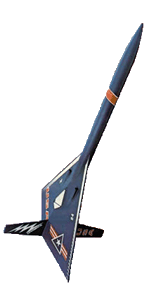Today's space dork news: DARPA, the United States' "let's think of some crazy technology to blow things up with" agency, delayed Wednesday's test of its Prompt Global Strike system because of rain in the target area.
All of which sounds dry and boring. But the details of this program are actually quite cool--or scary, depending on your point of view.
Prompt Global Strike, at least in this testing phase, uses what is basically a leftover Peacekeeper ICBM launcher to toss a wedge-shaped hypersonic vehicle out of the Earth's atmosphere, where it will begin to glide back down.
What happens next? The hypersonic test vehicle, creatively named "Hypersonic Test Vehicle-2" hits speeds of Mach 20 and uses jets of compressed gas to maneuver and orient itself at its target, which in this case is the Kwajalein Atoll. (I had to look it up--it's in the Marshall Islands, roughly 2,400 miles southwest of Honolulu. The U.S. does lots of missile testing there)
Because of its maneuvering capabilities, the vehicle is expected to have a 50 percent chance of landing within a circle 13 meters in diameter. (roughly 43 feet) That sounds like a pretty big target, but when you're shooting from 3,500 miles away, it's the size of a pea.

Hypersonic test vehicle, glowing with promise.
When I tried this as a kid, by the way, it looked like this:

Slower, bluer, more cardboardy.
Anyway. What makes this whole project interesting is the combination of speed, distance and accuracy. The idea is that if a target anyplace in the world is identified, one of these hypersonic gliders can hit it within an hour. Theoretically, you wouldn't even need a warhead, thanks to the magic of physics: The equation Ke=1/2mv^2 means a four-ton vehicle that has slowed to Mach 15, about 11,000 mph, would hit with about 22 BILLION joules of kinetic energy. That's the rough equivalent of detonating five tons of TNT.
The utility is that what the military calls "time-sensitive" targets can be hit without putting any soldiers in harm's way. GPS coordinates and a button push are all that is needed. Rogue nuclear programs and terrorist meetings are two obvious choices for that kind of action.
But there are scientific issues to overcome, including steering the vehicle; a test last year ended after nine minutes when the first test vehicle began spinning uncontrollably.
Political issues also pose a hurdle. A less-techologically challenging program in which conventional warheads were simply mounted on ICBMs was abandoned after other nuclear-armed countries noted that there was no way to tell a conventional strike from a nuclear one. And no one wants to start World War III.
And obviously the weather is an issue too.
No matter what the technology will be used for, this is a fascinating program. It is collecting data that are nearly impossible to get on the ground.
And by the time most of America is awake, 7 a.m. Pacific time, a Minotaur IV booster will have launched from Vandenberg Air Force Base in California. And about a half-hour later, if everything goes according to plan, the HTV will make a big splash in the South Pacific.


No comments:
Post a Comment